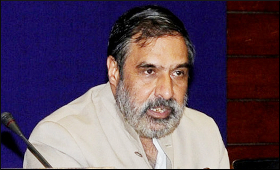|

|
India opens gates a lot wider for FDI
|
|

|
|
| Top Stories |
 |
|
|
|
Gyanendra Kumar Keshri | 17 Jul, 2013
In a clear signal to global investors that economic reforms will be
fast-tracked and norms for inflow of overseas capital eased further,
India Tuesday decided to hike the foreign direct investment limits in a
host of areas, notably telecom, insurance and defence.
The major
executive decision was taken at a meeting specially convened by Prime
Minister Manmohan Singh to discuss sectoral foreign investment caps and
attended by most of the key economic ministers, Commerce Minster Anand
Sharma told reporters in the national capital.
The decisions taken include hiking
foreign direct investment limit in the insurance sector to 49 percent
from the existing 26 percent and in the telecom sector to 100 percent
from 74 percent.
Despite opposition from Defence Minister A. K.
Antony, the government has decided to further open up defence sector for
overseas investments.
"In defence production, 26 percent
through FIPB (Foreign Investment Promotion Board) route stays. For
state-of-art technologies, FDI beyond this to be approved through CCS
(Cabinet Committee on Security)," Sharma said.
"Proposals beyond
26 percent where the project brings state-of-the-art technology, the
decision rests with CCS. Only those proposals will be recommended (to
the CCS) where state-of-the-art technology is involved," he added.
The
minister said the overseas investments would help provide access to
state-of-the-art technology to Indian firms involved in defence
production.
This apart, several approvals, earlier requiring
their routing through the Foreign Investment Promotion Board (FIPB) have
been brought under the automatic route.
"Basically, under the
automatic route, you apply, comply and go ahead," an official in the
commerce and industry ministry explained.
In single-brand retail trading FDI upto 49 percent will now be allowed through the automatic route.
"For 49 percent to 100 percent, the investment decision will be routed through FIPB," Sharma said.
For
the telecom industry, the decision to allow 100 percent foreign equity
will help a host of domestic promoters reeling under billions of
dollars of debt.
The move will allow the companies like Vodafone Group, Telenor and Sistema to operate in India without a local partner.
Experts
said in defence, apart from facilitating flow of money, the move will
fetch some state-of-the-art technology that was hitherto elusive.
The
government's move is expected to help curb the current account deficit
and provide support to the battered rupee, which hit a record low of
61.21 against a dollar last week. The rupee has lost almost 10 percent
of its value in the past two months. The rupee is the worst performer
among the emerging markets currencies so far this year.
The high current account deficit has been putting pressure on the Indian currency.
The
current account deficit, the difference between the country's imports
of goods, services and transfers and exports, touched a record high 4.8
percent of the GDP in the financial year ended March 31, 2013.
Economic growth slumped to five percent in 2012-13, the lowest in a decade.
Experts
said the liberal policy would result in great flow of overseas
investments in the country and help control the current account deficit
and revive economic growth.
"This should bring FDI into the
country, which will help in managing our current account deficit and
encourage fresh investments," said Naina Lal Kidwai, president,
Federation of Indian Chambers of Commerce and Industry.
The FDI inflows to India declined to $22.42 billion in 2012-13 from $36.50 billion in the previous year.
Here is the highlights of the government decisions:
* FDI limit in telecom to be hiked to 100 percent from 74 percent
* Cap in insurance sector to be raised to 49 percent from 26 percent
* Upto 49 percent FDI via automatic route in petroleum and natural gas refining
* In single brand retail, upto 49 percent under automatic route; beyond 49 percent through the FIPB route
*
In defence production, 26 percent FDI limit to stay; beyond 26 percent
it has to be approved by the Cabinet Committee on Security
* Upto 49 percent FDI through automatic route allowed in commodity exchanges
|
|
|
| |
|
|
|
|
|
|
|
|
|
|
|
|
|
|
| |
| Customs Exchange Rates |
| Currency |
Import |
Export |
US Dollar
|
₹88.70
|
₹87 |
UK Pound
|
₹119.90
|
₹116 |
Euro
|
₹104.25
|
₹100.65 |
| Japanese
Yen |
₹59.20 |
₹57.30 |
| As on 30 Oct, 2025 |
|
|
| Daily Poll |
 |
 |
| Who do you think will benefit more from the India - UK FTA in the long run?
|
|
|
|
|
|
| Commented Stories |
 |
|
|
|
|
|
| |
|